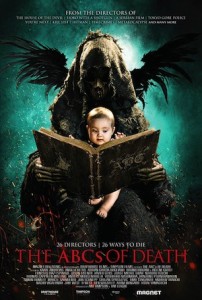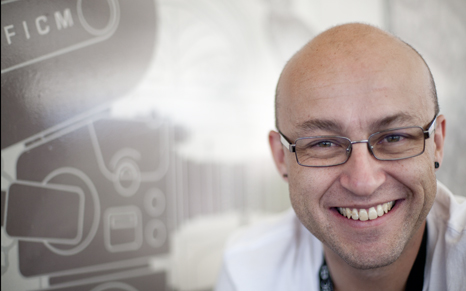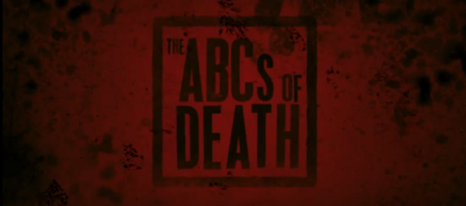 CHUD is very pleased to be a part of a group of 26 sites launching interviews with filmmakers today- specifically the 26 madmen behind the horror anthology The ABC’s Of Death. (You can find all 26 listed right here).
CHUD is very pleased to be a part of a group of 26 sites launching interviews with filmmakers today- specifically the 26 madmen behind the horror anthology The ABC’s Of Death. (You can find all 26 listed right here).
We’re joined here by Jorge Michel Grau, who is behind one of the more unnerving shorts, “I Is For Ingrown.” His short is definitely one you have to check out, but with the entire film available today on VOD, you should just strap in for the whole ride.
Our interview here was a bit complicated by language differences, so please excuse any awkward translations.
Renn: Tell me about the beginnings of your involvement in the project- did it come with your letter right away, or did you have some time to think generally before “I” was dealt to you?
Jorge: By the time I learned of the existence of the project I had not yet received an invitation to be part of it. It drove me crazy the idea of participating so I started to think of stories with the letter “T” that were still open to competition. I made a huge list of words to make a good story. Shortly after, Tim League wrote to tell me that I was invited to the project. It greatly excited me, moved me as I admired the work of the directors involved. Besides having a very good friendship with Adrian Garcia Bogliano and Nacho Vigalondo, the invitation allowed me to be part of that family. When I was assigned to “I” I had to put aside all ideas and developments that had been done to “T” and start from scratch.

Renn: What were some of your immediate considerations when realizing you’d be a part of a film with such a large amount of shorts surrounding yours?
Jorge: I always thought (and still do now) that the invitations to each of the directors were due to his style, his speech, his aesthetic. That’s why I decided to follow my path, an exercise in horror to explore a social crisis. In my country the killing of women is an act that we can not only not eradicate but it grows daily and the impunity is offensive. I think the invitation came for that, because my previous work walked that path, so I let it flow a story with these conditions. I think the strength of ABC’s of Death is that each of the directors, even if they belong to the horror genre, have their own identity.
Renn: Did the idea for Ingrown come to you suddenly and fully formed, or was it an idea/script that required a lot of sculpting?
Jorge: At first I made a selection of words with the letter “i”. Because of the language difference it was a slow selection, since the meanings and subtexts are not the same for both languages. I decided to do something more elaborate in speech, I wanted to talk about the “femicide” (murders of women) that goes unpunished. I thought the idea of a man sick with jealousy could lead to murder. So itchy with irritation that could be understood as the jealous rage that led to murder. Also, the word “impunity” in Spanish starts with “i”. Murder is a syringe and a “shot” … all the voice or speech or thought of a woman being murdered by her partner, begins with “I”. So, the idea of the letter “i” appears on several levels, not just in the murder.
Renn: Were there any particular challenges during filming?
Jorge: The hardest thing was to see the actress scratching her skin, the idea of dying by her own hands was a bit scary and the metaphor of the film; in Mexico, to be woman implies as tragic a fate as skinning alive. I was very interested to see if this was understood and could be seen. So we tested makeup, applied latex and peeled with the actress’ nails and a chemical that when it reacts simulates blood, all planned with Francesca Dalla Benetta. In the end, we had to do a little digital enhancement that gave force to the scene, Valerio Landa helped us in the digital process.
Renn: How do you approach directing an actor or actress through such unpleasant onscreen moments?
Jorge: I always talk with them head on, never leave anything to misinterpretation,
first doing research and selecting stimuli to give the actors. For example, in addition to searching news, studies and academic research that I convey to the actors, I select music, movies, books and paintings that they have to watch over the process to get in tune. So, I try to create a connection between the actors and my goals. However, I let the actors shape their character, allowing two universes together, the universe of fiction generated by the script, and the universe of the interpretation, generated by the actor. The strength of the film lies in the actor and his ability to play the character.
Renn: Tell me about making your decision with the title for “Ingrown,” especially since there is another big “I” word that would have also fit.
Jorge: At first I chose the word “itchy” because I wanted to make direct reference to a fit of jealousy, an itching or irritation caused by a feeling. Once the short was completed and commenting with Ant Timpson, we believed that the word “itchy” did not quite work right, but I was interested in a woman scratching her skin, to tear it, looked like he could be given more of a joke than a reflection, so the word “ingrown” portrayed more what I wanted to express, the rage that comes from within, it grows and flourishes. All this would not be possible without the indifference of the authorities in Mexico to let that happen daily.
Renn: What kind of personal challenge did you feel with this short? Did you set any goal to be the most shocking/disturbing/memorable/mysterious/etc?
Jorge: The first thought that came to mind was, “these are the big leagues” and I was nervous to do something that pleased. However, after the excitement and the invitation, I let the story flow, wanted to take the window display they gave me to talk about something that I worry about. I was never looking to do something memorable and disturbing or anything, I just wanted to talk about something that seems urgent. This is not filmmaking commitments, it is exploring yourself and now I found it in me. The horror film allows that.
Renn: What do you feel you’ll take away from this experience as you continue making films?
Jorge: The first and great was to make a movie out of my country, to participate in a different industry, production methods, contracts and many more, that sets us apart. On the other side, the most important, was to realize that the commitment of the story is related to me, nobody else. the exercise of exorcism is personal, just that. I learned that no matter what happens, the stories should be shot.
